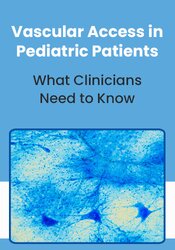

In the pediatric population, special considerations for vascular access need to be included in the plan of care. In this session, crucial topics for evidence-based care are covered, including the differences between central and peripheral vascular access devices (VADs) and the indications for each; proper and improper function of VADs and basic troubleshooting; how to provide high quality care and maintenance of VADs to ensure the reliability of the device; and the special considerations that must be undertaken with bedside procedures involving vascular access devices on pediatric patients.
Planning Committee Disclosure - No relevant relationships
All members of the PESI, Inc. planning committee have provided disclosures of financial relationships with ineligible organizations and any relevant non-financial relationships prior to planning content for this activity. None of the committee members had relevant financial relationships with ineligible companies or other potentially biasing relationships to disclose to learners. For speaker disclosures, please see the faculty biography.
NOTE: Tuition includes one free CE Certificate (participant will be able to print the certificate of completion after passing the online post-test (80% passing score) and completing the evaluation). Instructional methods will include PowerPoint, didactic lecture, and others.
Continuing Education Information: Listed below are the continuing education credit(s) currently available for this non-interactive self-study package. Program content is reviewed periodically per accrediting board rules for currency and appropriateness for credit. Credit approvals are subject to change. Please note, your state licensing board dictates whether self-study is an acceptable form of continuing education, as well as which credit types are acceptable for continuing education hours. Please refer to your state rules and regulations. If your profession is not listed, please contact your licensing board to determine your continuing education requirements and check for reciprocal approval.
For other credit inquiries not specified below, please contact info@pesi.com or 800-844-8260 before purchase.
Materials that are included in this course may include interventions and modalities that are beyond the authorized practice of your profession. As a licensed professional, you are responsible for reviewing the scope of practice, including activities that are defined in law as beyond the boundaries of practice in accordance with and in compliance with your profession's standards.
For Planning Committee disclosures, please see the statement above. For speaker disclosures, please see the faculty biography.
Earn up to 1.5 CE hours. Please see below, for more details, as credit amounts vary by state and profession.

PESI, Inc. is accredited as a provider of nursing continuing professional development by the American Nurses Credentialing Center’s Commission on Accreditation. Nurses completing these self-study materials will earn 1.5 contact hours. Expires: 01/15/2027.
PESI, Inc. is a provider approved by the California Board of Registered Nursing, Provider #: 17118 for 1.5 self-study contact hours.
** You will need to provide your license number to PESI. PESI must have this number on file in order for your hours to be valid.
PESI, Inc. is an approved provider by the Florida Board of Nursing. Provider #: FBN2858. These materials qualify for 1.5 self-study contact hours.

PESI, Inc. is an approved provider by the Iowa Board of Nursing. Provider #: 346. Nurses successfully completing these self-study materials will earn 1.5 self-study contact hours. Please email cepesi@pesi.com with your license number, include the title, speaker name and date. PESI must have this number on file in order for your hours to be valid.

PESI, Inc. is accredited by the Accreditation Council for Continuing Medical Education to provide continuing medical education for physicians. PESI, Inc. designates this enduring material for a maximum of 1.5 AMA PRA Category 1 Credit(s)™. This activity was originally recorded on 04/09/2024. It was last reviewed on 04/26/2024 and is valid until 04/25/2027.
Physicians should only claim credit commensurate with the extent of their participation in the activity. You are required to successfully complete and submit a post-test prior to receiving a certificate of completion.
AAPA accepts certificates of participation for educational activities certified for AMA PRA Category 1 Credit™ from organizations accredited by ACCME such as PESI. Physician assistants may receive a maximum of 1.5 hours for completing this self-study program. This activity was originally recorded on 04/09/2024. It was last reviewed on 04/26/2024 and is valid until 04/25/2027.
PESI, Inc. is accredited by the Accreditation Council for Continuing Medical Education to provide continuing medical education for physicians. PESI, Inc. designates this enduring material for a maximum of 1.5 AMA PRA Category 1 Credit(s)™.
This self-study activity qualifies for 1.5 continuing education clock hours as required by many national, state and local licensing boards and professional organizations. Save your activity advertisement and certificate of completion, and contact your own board or organization for specific requirements.
| File type | File name | Number of pages | |
|---|---|---|---|
| Manual - Vascular Access in Pediatric Patients (2.9 MB) | 25 Pages | Available after Purchase |
Elizabeth Ring, RN, BSN, VA-BC, is a Vascular Access-Board Certified registered nurse with 19 years’ experience. She has a background in emergency, interventional Radiology, Cardiac Cath Lab, Diagnostic Radiology, and Med Surg. She has been practicing as a vascular access nurse since 2018 with both adult and pediatric populations and is currently employed by both Baptist Health and Joe DiMaggio’s Childrens Hospital. Additionally, she does freelance writing health and nursing content with the purpose of educating, informing, and starting conversations.
Speaker Disclosures:
Access never expires for this product.
Types of VADs
Assessment and Troubleshooting
Care and maintenance
Satisfaction Guarantee
Your satisfaction is our goal and our guarantee. Concerns should be addressed to: PO Box 1000, Eau Claire, WI 54702-1000 or call 1-800-844-8260.
ADA Needs
We would be happy to accommodate your ADA needs; please call our Customer Service Department for more information at 1-800-844-8260.
PESI Mobile App
Access CE trainings on your phone or tablet through our free mobile app. Choose video or audio-only versions of online courses from the world’s best instructors, and complete your CE requirements anywhere, anytime, at your own pace.
Please wait ...